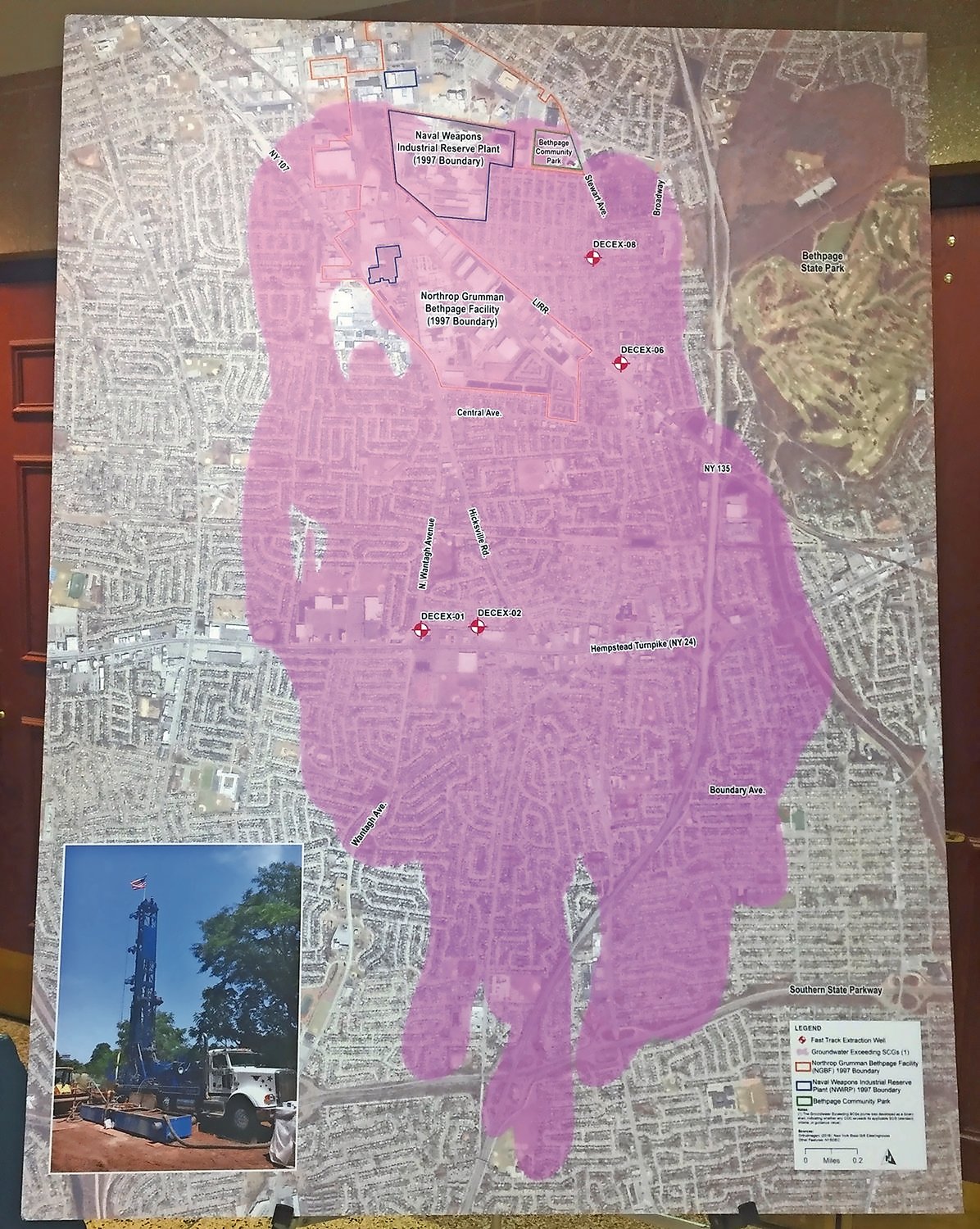DEC approves $585 million plume cleanup
Regulators from the New York State Department of Environmental Conservation gave the nod on Dec. 20 to a $585 million plan to remediate the Bethpage plume, a 7-square-mile section of the groundwater within the Long Island Sole-Source System that extends into Seaford and Wantagh. The plan, proposed in detail in June, constitutes the first concrete step in a cleanup effort that ultimately will take an estimated 110 years to complete at a cost variously estimated at between $30 billion and
$70 billion in 2020 dollars.
The plume is allegedly the result of contamination from the development and production of prototype and experimental weapons systems by Northrop Grumman Corp., under contract with the U.S. Navy, from the 1930s to the 1990s.
Northrop Grumman and the Navy have until the beginning of January to accept the DEC’s proposed plan and agree to fund the cleanup. Otherwise, the state was set to move forward on its own and seek reimbursement later through litigation.
According to DEC estimates, the plume extends to a depth of 900 feet and runs south from Bethpage through Seaford and Wantagh, past the Southern State Parkway. From east to west, it stretches roughly from the Seaford Oyster Bay Expressway to Gardiners Avenue in Levittown.
DEC approval means that work can now begin to clean up the contamination. To date, a total of 27 public water supply wells have been affected by contamination from the plume, according to the DEC.
To begin the project, 24 groundwater extraction wells will be drilled — eight within the 600-acre Navy-Grumman site and another 16 along the borders of the plume. The wells will pump out roughly 17.5 million gallons of water per day, which will be cleaned at one of five treatment plants using “air-stripping technology,” according to a technical summary issued last week by the DEC. “Advanced oxidation process will be used for 1,4 dioxane removal,” according to the summary.
The treated water will either be sent to an aquifer via a recharge basin at Bethpage State Park, reused for irrigation or pumped into Massapequa Creek, according to the summary. Conveyance of the water from treatment plants to discharge locations will require the installation of more than 23 miles of underground pipelines.
Northrop Grumman began its own ultimately unsuccessful efforts to contain the contamination in 1998, at a cost of some $200 million, according to company statements. Navy spokespeople estimated that it has spent more than $130 million on containment in the same period.
Those affected by the contamination include customers in New York American Water’s Merrick District, the Bethpage Water District and the Massapequa Water District. The plume is currently moving southward at an estimated one foot
per year.
Both Grumman and the Navy pushed back against the initial proposal, with Grumman calling the cleanup “unnecessary, infeasible and impractical” in a statement issued last August. The Navy weighed in a month later, saying the plan “fails to adequately assess whether the cost of the proposed remedy is proportional to the overall effectiveness.”
“I’ve talked with the folks running it, and I’m convinced they know what they’re doing and are on top of it,” State Sen. John Brooks, a Seaford Democrat, countered at the time. “Overall, it’s a great plan, and [the state] has an absolute commitment to get this done.”
“This is a major milestone in the many-decades-long effort to hold Grumman and the Navy accountable,” DEC Commissioner Basil Seggos said in an interview with news outlets when the plan’s approval was announced last month. “The plan is . . . feasible and would effectively stop the further spread of contamination within the aquifer.”
The plan is based on a $6 million groundwater study carried out by the U.S. Geological Survey, Seggos explained, adding that it provided clearer mapping of the plume than had been previously available.
The plan was not the most expensive proposal put forward when the state first issued a request for proposals, according to Deputy DEC Commissioner Martin Brand. Plans ranged from $332 million to $748 million, he said. But this one was the most aggressive, making it possible to contain and clean up a major part of the plume in as little as 30 years.
The plume contains some two dozen contaminants, including trichloroethylene, a suspected human carcinogen, and 1,4 dioxane, which the Environmental Protection Agency recently upgraded to a “likely” carcinogen.
Nassau County residents all derive their water from surface-drilled wells. Three aquifers — the Upper Glacial, Magothy and Lloyd — flow west to east across the island, at a depth ranging from about 700 feet to as much as 1,800 feet.
Mallory Wilson contributed to this story.

 56.0°,
A Few Clouds
56.0°,
A Few Clouds 





